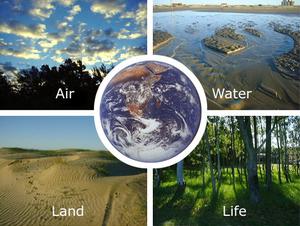The driving force for the atmospheric circulation is the global distribution of energy. The angle at which the Sun's ray strike Earth changes from the equator toward the poles, The result is that incoming solar radiation decreases with latitude. More solar radiation is received in the tropics than at the poles, resulting in an equator-pole temperature gradient. The temperature gradient drives the atomosperic circulation because of the inverse relationship between the temperature and the density of a gas: higher temperature produce lower densities. Differences in the distribution of global temperature cause differences in air density and, therefore pressure. Air tend to move from areas of high pressure to areas of low pressure. These large-scal movement of air produce the global wind belts.
As with the atmosphere, the driving force for the oceanic circulation is the global distribution of energy. Unlike the atmosphere, however, the ocean circulation is driven by indirectly by temperature differences: the surface-ocean circulation is, in fact, driven by the circulation of atmosphere. Due to friction, wind blowing over the ocean surface water along, producing ocean currents. The pattern of surface-ocean currents is modified by the Coriolis effect, a consequence of Earth's rotation, and by the distribution of land and oceans,
The solid Earth is dynamic, not static. Wegener's idea of drifting continent proposed in the early 20th century has largely been substantiated. New seafloor is created at mid-ocean ridges and moves outward as oceans basins grow. Old seafloor is distorted at deep-sea trenches in subduction zones. Earthquake outline the surface of the slab of oceanic lithosphere being sub-ducted beneath the continent; their foci along a continental margin become ever deeper away from the trench. Deeper probing of Earth's interior has revealed heterogeneity in composition and temperature that can be the result only of large-scale circulation in the mantle or the outer core.
There is also the global carbon cycle that occur on land and in oceans and involve both biological and nonbiological chemical reaction on the Earth.
Some of the characteristics of life that allow it to play an important role in the Earth system are its tendency toward exponential growth, its need for energy, its tendency to pollute, and tis versatility.
The circulations of the atmosphere, oceans, solid and energy and so on are support the Earth and the life. They are play an important role on the working of the earth.




